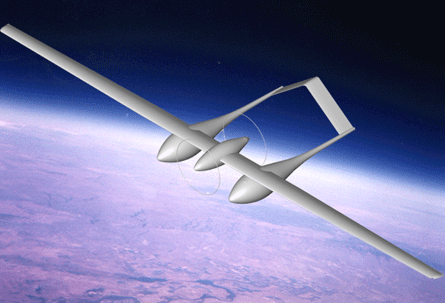Persistent surveillance is becoming a pressing requirement for US forces, spawning a number of programmes aimed at demonstrating unmanned air vehicles with endurance capabilities ranging from weeks to years.
The latest of these is the US Defense Advanced Research Projects Agency’s (DARPA) VULTURE programme to demonstrate the ability to keep a heavier-than-air UAV on station for more than five years.
VULTURE – which stands for Very-high altitude, Ultra-endurance, Loitering Theatre Unmanned Reconnaissance Element – is a complement to DARPA’s ISIS (Integrated Sensor Is Structure) programme to demonstrate technology for an unmanned airship capable of remaining on station in the stratosphere for a year or more.
DARPA has invited proposals for the VULTURE programme and plans an industry day on 7 June. The agency is looking for the capability to “deliver and maintain a 1,000lb, 5kW airborne payload for an uninterrupted period exceeding five years with a 99%+ on-station reliability”.
“VULTURE, in effect, will be a retaskable, persistent satellite capability in an aircraft package,” says DARPA in its fiscal year 2008 budget submission, which indicates the UAV will be solar powered, like the
Key technologies will involve energy collection, dense energy storage, efficient propulsion, robotic refueling, and lightweight structures. The solicitation also mentions “autonomous materiel transfer”, suggesting the ability to change out payloads while airborne.
DARPA’s plan is for a three-phase programme beginning with concept definition and progressing through risk reduction, including flying a subscale vehicle, to an operational demonstration with the design payload.
Other, less-ambitious persistent surveillance programmes are also gathering pace. US Special Operations Command plans to demonstrate the tactical utility of a hydrogen-powered UAV capable for five- to seven-day missions at 55,000-65,000ft.
The so-called joint capability technology demonstration (JCTD) will involve Aerovironment’s Global Observer UAV, which uses liquid hydrogen fuel cells, with the objective of a seven-day mission carrying a 380lb payload.
A contract for the three-year demonstration, valued at up to $129 million, is expected to be awarded later this year. The US Department of Defense has also announced plans for a second demonstration involving Qinetiq’s solar-powered Zephyr UAV.
The Zephyr JCTD is intended to demonstrate and transition into service to met urgent operational requirements a low-cost UAV capable of surveillance and communications-relay missions lasting several months.
Boeing, meanwhile, says it is working with the US Missile Defense Agency (MDA) to launch a demonstration programme involving its HALE high-altitude long-endurance UAV.
The HALE is powered by two conventional piston engines modified to burn liquid hydrogen fuel, and will fly at 65,000ft, giving the large UAV an endurance of more than seven days while carrying a payload of up to 2,000lb.

Boeing is teamed with Aurora Flight Sciences, with is already building the Orion HALL (high-altitude, long-loiter) UAV for a US Army Space & Missile Defense Command technology demonstration.
Powered by a single automotive engine modified to burn liquid hydrogen, the Orion is designed to have a four-day endurance at 65,000ft, carrying a 400lb payload.
The MDA, meanwhile, has cancelled a contract with Lockheed Martin to demonstrate the High-Altitude Airship (HAA), citing lack of funds in the FY2008 budget. The solar-powered HAA was intended was intended to operate as a geo-stationary surveillance platform above 60,000ft for a month.
Other featured UAVs:
Source: FlightGlobal.com























